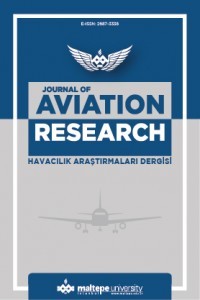Ekip Kaynak Yönetiminin Sivil Havacılık Kazalarını Azaltmasındaki Etkisi
ekip kaynak yönetimi, insan faktörleri, sivil havacılık
The Impact of Crew Resource Management on Reducing the Accidents in Civil Aviation
CRM, Human Factors,
___
- Dunn, E. J., Mills, P. D., Neily, J., Crittenden, M. D., Carmack, A. L., & Bagian, J. P. (2007). Medical team training: applying crew resource management in the Veterans Health Administration. The Joint Commission Journal on Quality and Patient Safety, 33(6), 317-325.
- Flin, R., & Martin, L. (2001). Behavioral markers for crew resource management: A review of current practice. The International Journal of Aviation Psychology, 11(1), 95-118.
- Flin, R., O’Connor, P., & Mearns, K. (2002). Crew resource management: improving team work in high reliability industries. Team performance management: an international journal, 8(3/4), 68-78.
- Gross, B., Rusin, L., Kiesewetter, J., Zottmann, J. M., Fischer, M. R., Prückner, S., & Zech, A. (2019). Crew resource management training in healthcare: a systematic review of intervention design, training conditions and evaluation. BMJ open, 9(2), e025247.
- Gross, B., Rusin, L., Kiesewetter, J., Zottmann, J. M., Fischer, M. R., Prückner, S., & Zech, A. (2019). Microlearning for patient safety: Crew resource management training in 15-minutes. PloS one, 14(3), e0213178.
- Hefner, J. L., Hilligoss, B., Knupp, A., Bournique, J., Sullivan, J., Adkins, E., & Moffatt-Bruce, S. D. (2017). Cultural transformation after implementation of crew resource management: is it really possible?. American Journal of Medical Quality, 32(4), 384-390.
- Helmreich, R. L., & Merritt, A. C. (2017, November). 11 Safety and error management: The role of crew resource management. In Aviation Resource Management: Proceedings of the Fourth Australian Aviation Psychology Symposium: v. 1: Proceedings of the Fourth Australian Aviation Psychology Symposium. Routledge.
- Helmreich, R. L., & Wilhelm, J. A. (1991). Outcomes of crew resource management training. The International journal of aviation psychology, 1(4), 287-300.
- Helmreich, R. L., Merritt, A. C., & Wilhelm, J. A. (1999). The evolution of crew resource management training in commercial aviation. The international journal of aviation psychology, 9(1), 19-32.
- Kanki, B. G. (2019). Communication and crew resource management. In Crew resource management (pp. 103-137). Academic Press.
- Kemper, P. F., de Bruijne, M., van Dyck, C., So, R. L., Tangkau, P., & Wagner, C. (2016). Crew resource management training in the intensive care unit. A multisite controlled before–after study. BMJ Qual Saf, 25(8), 577-587.
- KERN Tony., Controlling Pilot Error, Culture, Enviroment,CRM, R.R.Donnelley &Sons Company, McGraw-Hill, Newyork, 2001.
- Krivonos, R., Revnivtsev, M., Lutovinov, A., Sazonov, S., Churazov, E., & Sunyaev, R. (2007). INTEGRAL/IBIS all-sky survey in hard X-rays. Astronomy & Astrophysics, 475(2), 775-784.
- Malec, J. F., Torsher, L. C., Dunn, W. F., Wiegmann, D. A., Arnold, J. J., Brown, D. A., & Phatak, V. (2007). The mayo high performance teamwork scale: reliability and validity for evaluating key crew resource management skills. Simulation in Healthcare, 2(1), 4-10.
- Mempin, R. L., Simon, W. M., Napolitano, J. D., Brook, R. P., Hall, O. L., Vangala, S., & Lee, E. S. (2019). Comparing the effectiveness of a hybrid simulation/lecture session versus simulation alone in teaching crew resource management (CRM) skills: a randomised controlled trial. BMJ Simulation and Technology Enhanced Learning, 5(4), 198-203.
- Muzaffer Çetingüç, Havacılık ve Uzak Pskolojisi (2016)
- Pizzi, L., Goldfarb, N. I., & Nash, D. B. (2001). Crew resource management and its applications in medicine. Making health care safer: A critical analysis of patient safety practices, 44, 511-519.
- Salas, E., Burke, C. S., Bowers, C. A., & Wilson, K. A. (2001). Team training in the skies: does crew resource management (CRM) training work?. Human Factors, 43(4), 641-674.
- Salas, E., Prince, C., Bowers, C. A., Stout, R. J., Oser, R. L., & Cannon-Bowers, J. A. (1999). A methodology for enhancing crew resource management training. Human Factors, 41(1), 161-172.
- SCHWARTZ D., “CRM Training for Parts 91 and 135 Operations”, In proceedings of the NASA/MAC WorkShop on Cockpit Resource Management, NASA Conference Publication 2455, NASA Ames Research Center, Moffett Field, CA, USA, 1987
- Terzioğlu, M. (2007). Uçak kazalarının nedeni olarak insan hatalarını azaltmada ekip kaynak yönetimi (Doctoral dissertation, DEÜ Sosyal Bilimleri Enstitüsü).
- Wahl, A. M., & Kongsvik, T. (2018). Crew resource management training in the maritime industry: a literature review. WMU Journal of Maritime Affairs, 17(3), 377-396.
- http://www.hvtd.org
- https://tr.wikipedia.org
- https://www.airlinehaber.com
- https://www.goklerdeyiz.net
- http://www.ucak1.com
- Yayın Aralığı: Yılda 2 Sayı
- Başlangıç: 2019
- Yayıncı: Maltepe Üniversitesi
Ümit DOĞAN, Şafak AKTEMUR, Mustafa UZGÖR, Hakkı Okan YELOĞLU
Gig Ekonomisinin Havacılık Sektöründeki Geleceği
Gülaçti ŞEN, Ahmet Hakan ARSLAN, Erhan BÜTÜN
Ekip Kaynak Yönetiminin Sivil Havacılık Kazalarını Azaltmasındaki Etkisi
Kağan Cenk MIZRAK, Filiz MIZRAK
Rezistif Kuvvet Sensörü Uygulamasıyla Uçak Tuvaletleri Vakum Sistemlerinin İyileştirilmesi
Kerim İsmail KARACA, Mehlika KARAARSLAN
Dalga Kılavuzlarındaki Bükmelerin Havacılık ve Havacılık Dışı Uygulamalara Etkileri
